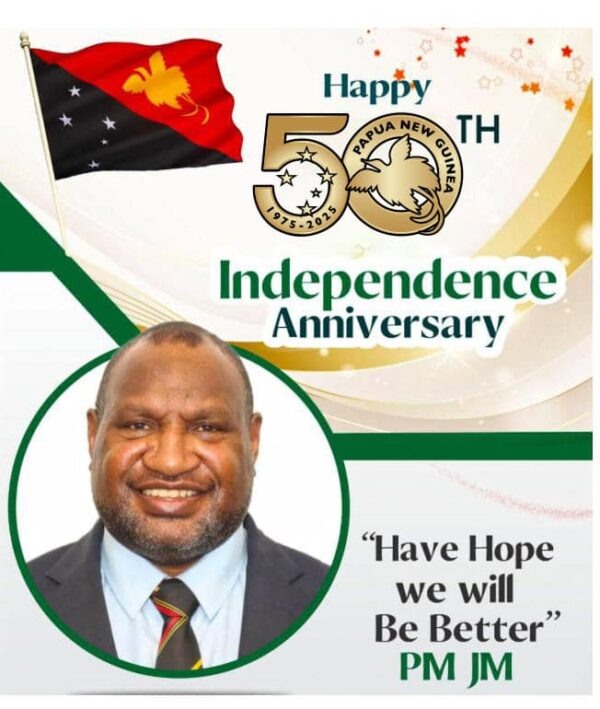AUGUST 31 2022
Prime Minister Hon. James Marape Hon. James Marape says “the story of our country is not bad” as many make it out to be.
He said this today (August 31 2022) when welcoming the 2022 Mid-Year Economic and Fiscal Outlook (MYEFO) presented by Treasurer Ian Ling-Stuckey which highlighted the fact that the Papua New Guinea economy was on the rebound.
PM Marape predicted that by 2027, the Budget would be in surplus, and by the mid-2030s PNG would have paid off all its total sovereign debt on its way to becoming a K200 billion economy.

Among the good news for PNG:
- The latest MYEFO figures have the PNG economy growing by the largest Kina amount in history – from K82.6 billion in 2020 to K92.6 billion in 2021 and K110.3 billion in 2022. The K27.6 billion increase in the economy over the last two years is more than double the K12.4 billion increase in the economy during 2014 and 2015 as the PNG LNG Project started.
- Treasury estimates that inflation will average 6.2 per cent in 2022 after incorporating the lower cost pressures by removing fuel taxes, assistance to lower the price of flour, rice, tinned fish and Ox & Palm; and lower education costs from the School Project Fee subsidy. The MYEFO forecasts that inflation rate will drop down to 5.6 per cent in 2023 and continue declining.
- The MYEFO forecasts an increase in revenue from K13.67 billion in 2021 to K17.07 billion in 2022 – which is a 23.1 per cent increase on revenue outcomes in 2021. Not only was the ambitious revenue target of K16.19 billion surpassed, it was exceeded by K875.8 million; and
- PNG’s debt to GDP ratio in 2022 will not fall from 53.3 per cent down to 49.1 per cent, which is even lower than the 51.6 per cent in 2021.
“At the macro level, the story of our country is not bad,” PM Marape said.
“Our country has been travelling on a positive road thus far.
“In 1975 our economy was a K5 billion economy, in 2011 it was K44 billion, in 2018 it was K79.6 billion.”
PM Marape commended Treasurer Ling-Stuckey for a sterling performance over the last three hard years.
“Despite many criticisms, he (Ling-Stuckey) has ensured our short-term measures to keep MV PNG floating, in tough waters, are paying off.
“Over the last three years, we have climbed from a K79.6 billion economy of 2018, to an International Monetary Fund (IMF) forecast of K110 billion by the end of this year.
“The thermometer, in as far as our economic expansion is concerned, is rising while other countries have regressed.”
PM Marape stressed that there was a lot more work in the short, medium and long terms to be done by everyone in the country.
PM Marape said Porgera Mine, P’nyang LNG, Papua LNG, Pasca LNG and Wafi-Golpu Mine should be in operation as a matter of urgency.
“Short term measures include bringing back Porgera at the earliest,” he said.
“P’nyang LNG will run at the back of Papua LNG construction, so instead of just a four-year construction period like the PNG LNG from 2011-2013, P’nyang and Papua will be constructed over an eight-year period.
“That will mean a windfall economy as a result of construction from 2013 right up to 2021.
“We will make a concerted effort to consult all landowners and all provincial governments in Gulf, Western and Enga provinces.
“The smaller Pasca Project, the easiest, lowest-hanging fruit, will be reactivated and that will hopefully by concluded at the very earliest.
“I am very keen to work with the Morobe Provincial Government, and Governor Hon. Luther Wenge, on the much talked about Wafi-Golpu Project.
“These five projects will be progressed over the next 10 years and give us the window for a K200 billion economy over the next 10 years.”
PM Marape said everyone should work hard over the short, medium and long terms to progress the country.
“The hard work starts today,” he said.
“Everyone wants services but we must find the money to pay for these.
“We must not be free riders going forward.
“Everyone must contribute to the growth of our country, and when you contribute, you receive services.
“We must start mobilising our people to get into agriculture, forestry, fisheries and other small businesses.”
******
![]()
